Employability Skills Report: Timbacourt Case Study and Recommendations
VerifiedAdded on 2020/01/28
|14
|4415
|52
Report
AI Summary
This report analyzes employability skills within the context of a case study involving Timbacourt, a retail company. It begins by outlining job descriptions and person specifications for a training manager and a retail sales person, emphasizing the development of responsibilities and performance objectives. The report then evaluates methods for assessing employee effectiveness, including self-evaluation, scoring, and paired comparison. Recommendations for improvement focus on 360-degree feedback, performance appraisal systems, and setting clear targets. Motivational techniques, such as incentives, growth opportunities, and implementation of motivational theories, are also discussed. The report further explores solutions to communication problems within Timbacourt, suggesting training programs and the implementation of ICT. It examines communication styles at different management levels and identifies effective time management strategies, including prioritization, worksheets, and daily planners. Finally, the report analyzes the roles individuals play in a team, including shaper, implementer, and coordinator, and provides alternative ways to complete tasks and achieve team goals. The report also covers tools and techniques for problem-solving and the potential impact of implementing proposed strategies within the company.
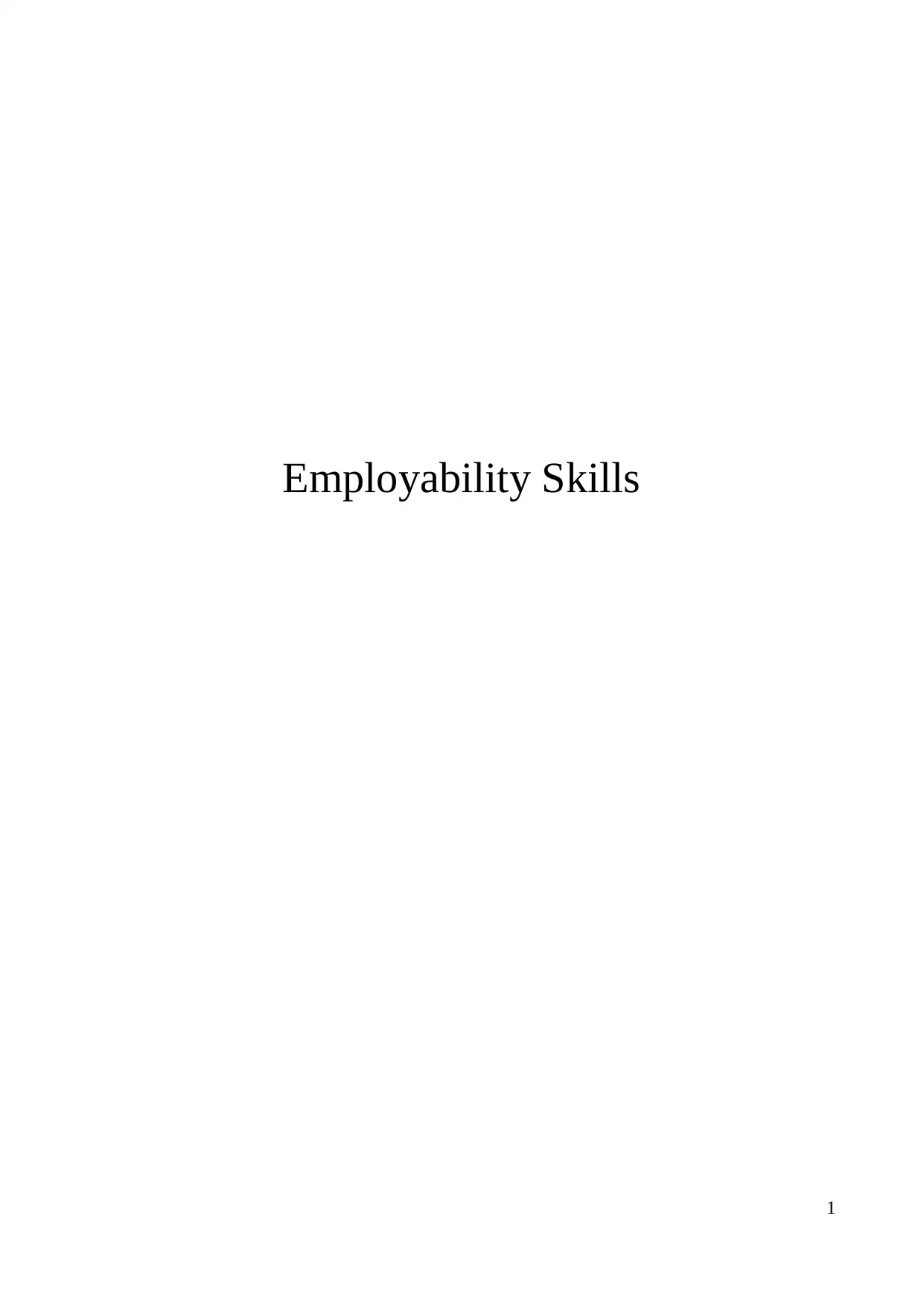
Employability Skills
1
1
Paraphrase This Document
Need a fresh take? Get an instant paraphrase of this document with our AI Paraphraser
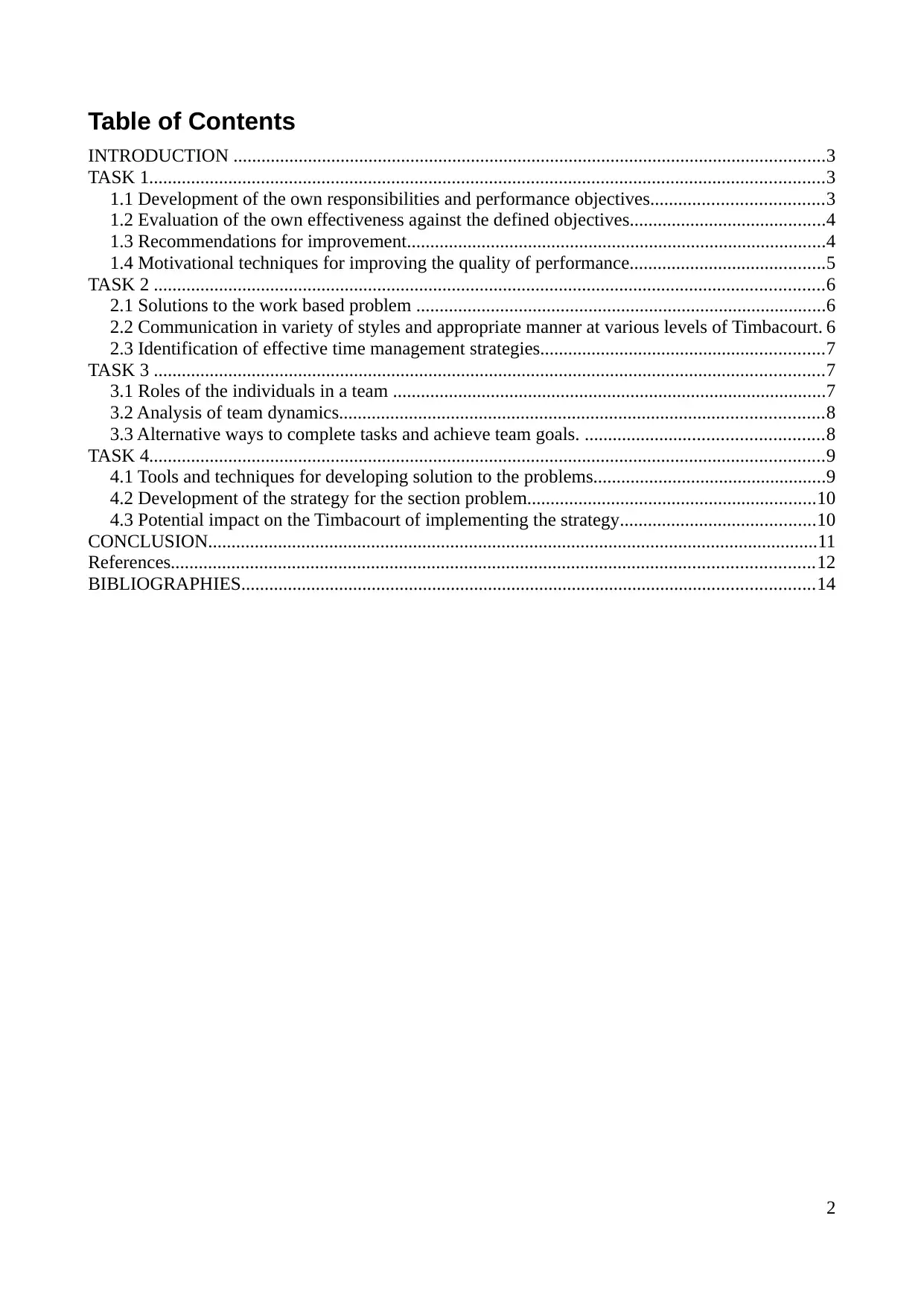
Table of Contents
INTRODUCTION ...............................................................................................................................3
TASK 1.................................................................................................................................................3
1.1 Development of the own responsibilities and performance objectives.....................................3
1.2 Evaluation of the own effectiveness against the defined objectives..........................................4
1.3 Recommendations for improvement..........................................................................................4
1.4 Motivational techniques for improving the quality of performance..........................................5
TASK 2 ................................................................................................................................................6
2.1 Solutions to the work based problem ........................................................................................6
2.2 Communication in variety of styles and appropriate manner at various levels of Timbacourt. 6
2.3 Identification of effective time management strategies.............................................................7
TASK 3 ................................................................................................................................................7
3.1 Roles of the individuals in a team .............................................................................................7
3.2 Analysis of team dynamics........................................................................................................8
3.3 Alternative ways to complete tasks and achieve team goals. ...................................................8
TASK 4.................................................................................................................................................9
4.1 Tools and techniques for developing solution to the problems..................................................9
4.2 Development of the strategy for the section problem..............................................................10
4.3 Potential impact on the Timbacourt of implementing the strategy..........................................10
CONCLUSION...................................................................................................................................11
References..........................................................................................................................................12
BIBLIOGRAPHIES...........................................................................................................................14
2
INTRODUCTION ...............................................................................................................................3
TASK 1.................................................................................................................................................3
1.1 Development of the own responsibilities and performance objectives.....................................3
1.2 Evaluation of the own effectiveness against the defined objectives..........................................4
1.3 Recommendations for improvement..........................................................................................4
1.4 Motivational techniques for improving the quality of performance..........................................5
TASK 2 ................................................................................................................................................6
2.1 Solutions to the work based problem ........................................................................................6
2.2 Communication in variety of styles and appropriate manner at various levels of Timbacourt. 6
2.3 Identification of effective time management strategies.............................................................7
TASK 3 ................................................................................................................................................7
3.1 Roles of the individuals in a team .............................................................................................7
3.2 Analysis of team dynamics........................................................................................................8
3.3 Alternative ways to complete tasks and achieve team goals. ...................................................8
TASK 4.................................................................................................................................................9
4.1 Tools and techniques for developing solution to the problems..................................................9
4.2 Development of the strategy for the section problem..............................................................10
4.3 Potential impact on the Timbacourt of implementing the strategy..........................................10
CONCLUSION...................................................................................................................................11
References..........................................................................................................................................12
BIBLIOGRAPHIES...........................................................................................................................14
2
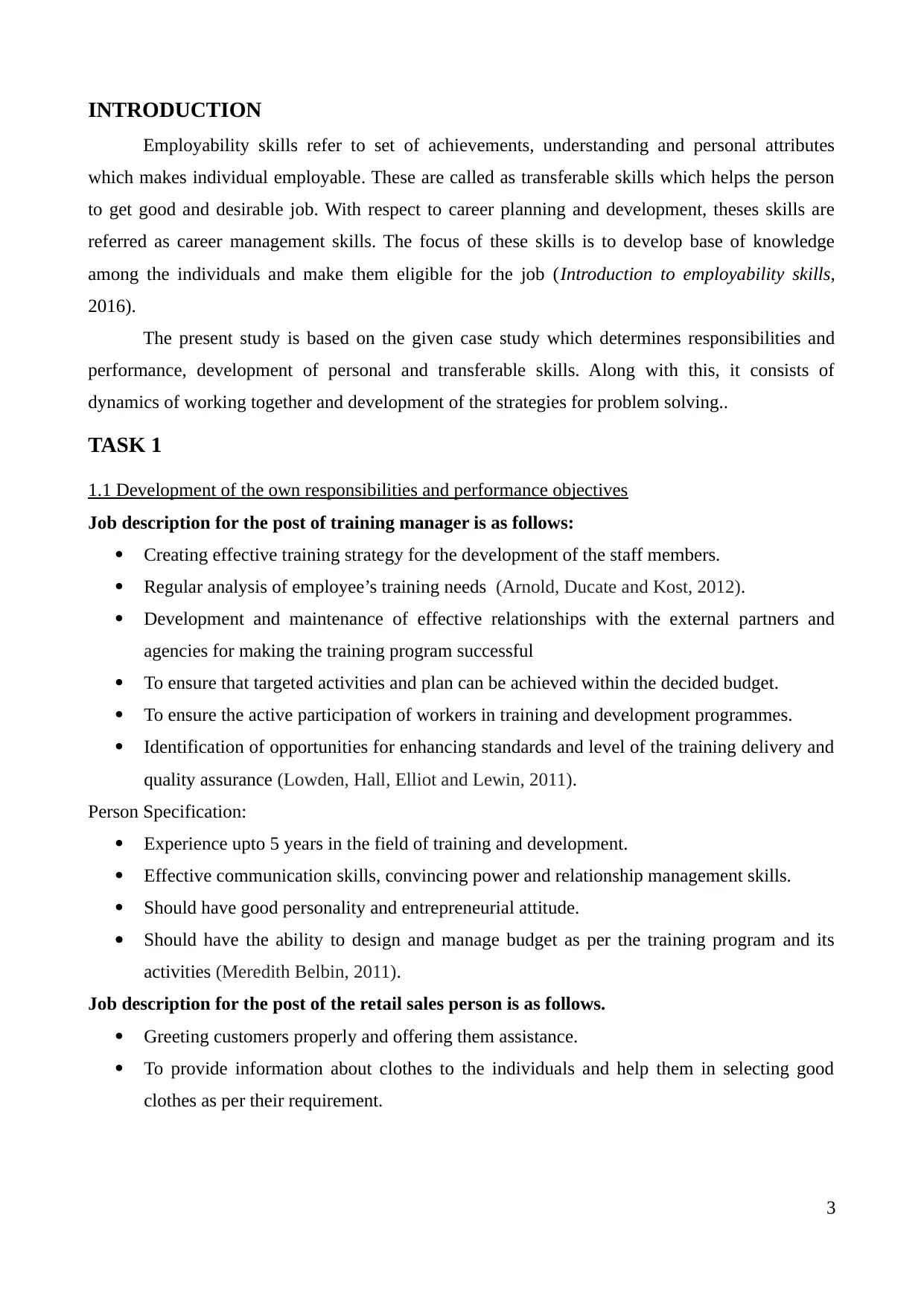
INTRODUCTION
Employability skills refer to set of achievements, understanding and personal attributes
which makes individual employable. These are called as transferable skills which helps the person
to get good and desirable job. With respect to career planning and development, theses skills are
referred as career management skills. The focus of these skills is to develop base of knowledge
among the individuals and make them eligible for the job (Introduction to employability skills,
2016).
The present study is based on the given case study which determines responsibilities and
performance, development of personal and transferable skills. Along with this, it consists of
dynamics of working together and development of the strategies for problem solving..
TASK 1
1.1 Development of the own responsibilities and performance objectives
Job description for the post of training manager is as follows:
Creating effective training strategy for the development of the staff members.
Regular analysis of employee’s training needs (Arnold, Ducate and Kost, 2012).
Development and maintenance of effective relationships with the external partners and
agencies for making the training program successful
To ensure that targeted activities and plan can be achieved within the decided budget.
To ensure the active participation of workers in training and development programmes.
Identification of opportunities for enhancing standards and level of the training delivery and
quality assurance (Lowden, Hall, Elliot and Lewin, 2011).
Person Specification:
Experience upto 5 years in the field of training and development.
Effective communication skills, convincing power and relationship management skills.
Should have good personality and entrepreneurial attitude.
Should have the ability to design and manage budget as per the training program and its
activities (Meredith Belbin, 2011).
Job description for the post of the retail sales person is as follows.
Greeting customers properly and offering them assistance.
To provide information about clothes to the individuals and help them in selecting good
clothes as per their requirement.
3
Employability skills refer to set of achievements, understanding and personal attributes
which makes individual employable. These are called as transferable skills which helps the person
to get good and desirable job. With respect to career planning and development, theses skills are
referred as career management skills. The focus of these skills is to develop base of knowledge
among the individuals and make them eligible for the job (Introduction to employability skills,
2016).
The present study is based on the given case study which determines responsibilities and
performance, development of personal and transferable skills. Along with this, it consists of
dynamics of working together and development of the strategies for problem solving..
TASK 1
1.1 Development of the own responsibilities and performance objectives
Job description for the post of training manager is as follows:
Creating effective training strategy for the development of the staff members.
Regular analysis of employee’s training needs (Arnold, Ducate and Kost, 2012).
Development and maintenance of effective relationships with the external partners and
agencies for making the training program successful
To ensure that targeted activities and plan can be achieved within the decided budget.
To ensure the active participation of workers in training and development programmes.
Identification of opportunities for enhancing standards and level of the training delivery and
quality assurance (Lowden, Hall, Elliot and Lewin, 2011).
Person Specification:
Experience upto 5 years in the field of training and development.
Effective communication skills, convincing power and relationship management skills.
Should have good personality and entrepreneurial attitude.
Should have the ability to design and manage budget as per the training program and its
activities (Meredith Belbin, 2011).
Job description for the post of the retail sales person is as follows.
Greeting customers properly and offering them assistance.
To provide information about clothes to the individuals and help them in selecting good
clothes as per their requirement.
3
⊘ This is a preview!⊘
Do you want full access?
Subscribe today to unlock all pages.

Trusted by 1+ million students worldwide
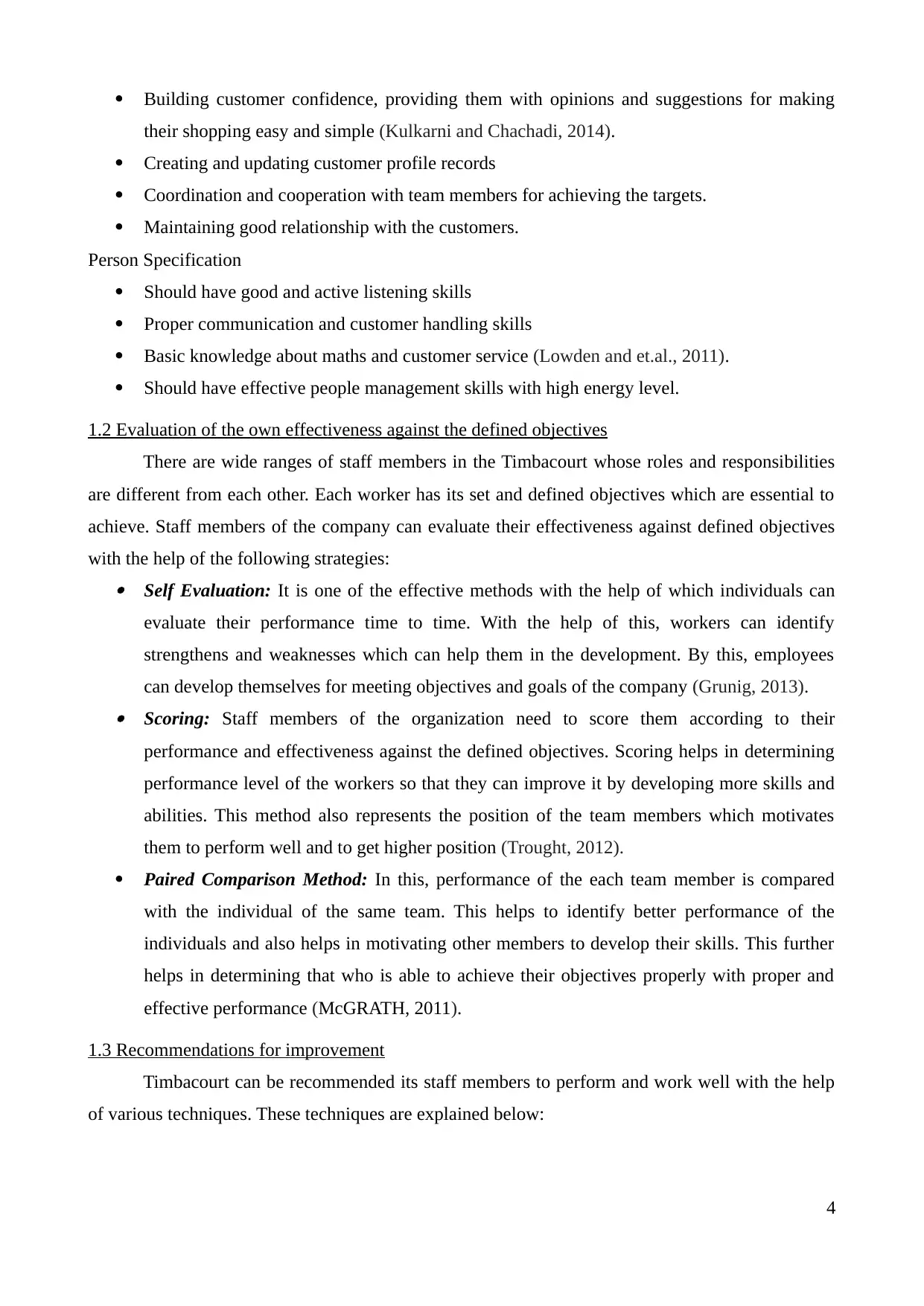
Building customer confidence, providing them with opinions and suggestions for making
their shopping easy and simple (Kulkarni and Chachadi, 2014).
Creating and updating customer profile records
Coordination and cooperation with team members for achieving the targets.
Maintaining good relationship with the customers.
Person Specification
Should have good and active listening skills
Proper communication and customer handling skills
Basic knowledge about maths and customer service (Lowden and et.al., 2011).
Should have effective people management skills with high energy level.
1.2 Evaluation of the own effectiveness against the defined objectives
There are wide ranges of staff members in the Timbacourt whose roles and responsibilities
are different from each other. Each worker has its set and defined objectives which are essential to
achieve. Staff members of the company can evaluate their effectiveness against defined objectives
with the help of the following strategies: Self Evaluation: It is one of the effective methods with the help of which individuals can
evaluate their performance time to time. With the help of this, workers can identify
strengthens and weaknesses which can help them in the development. By this, employees
can develop themselves for meeting objectives and goals of the company (Grunig, 2013). Scoring: Staff members of the organization need to score them according to their
performance and effectiveness against the defined objectives. Scoring helps in determining
performance level of the workers so that they can improve it by developing more skills and
abilities. This method also represents the position of the team members which motivates
them to perform well and to get higher position (Trought, 2012).
Paired Comparison Method: In this, performance of the each team member is compared
with the individual of the same team. This helps to identify better performance of the
individuals and also helps in motivating other members to develop their skills. This further
helps in determining that who is able to achieve their objectives properly with proper and
effective performance (McGRATH, 2011).
1.3 Recommendations for improvement
Timbacourt can be recommended its staff members to perform and work well with the help
of various techniques. These techniques are explained below:
4
their shopping easy and simple (Kulkarni and Chachadi, 2014).
Creating and updating customer profile records
Coordination and cooperation with team members for achieving the targets.
Maintaining good relationship with the customers.
Person Specification
Should have good and active listening skills
Proper communication and customer handling skills
Basic knowledge about maths and customer service (Lowden and et.al., 2011).
Should have effective people management skills with high energy level.
1.2 Evaluation of the own effectiveness against the defined objectives
There are wide ranges of staff members in the Timbacourt whose roles and responsibilities
are different from each other. Each worker has its set and defined objectives which are essential to
achieve. Staff members of the company can evaluate their effectiveness against defined objectives
with the help of the following strategies: Self Evaluation: It is one of the effective methods with the help of which individuals can
evaluate their performance time to time. With the help of this, workers can identify
strengthens and weaknesses which can help them in the development. By this, employees
can develop themselves for meeting objectives and goals of the company (Grunig, 2013). Scoring: Staff members of the organization need to score them according to their
performance and effectiveness against the defined objectives. Scoring helps in determining
performance level of the workers so that they can improve it by developing more skills and
abilities. This method also represents the position of the team members which motivates
them to perform well and to get higher position (Trought, 2012).
Paired Comparison Method: In this, performance of the each team member is compared
with the individual of the same team. This helps to identify better performance of the
individuals and also helps in motivating other members to develop their skills. This further
helps in determining that who is able to achieve their objectives properly with proper and
effective performance (McGRATH, 2011).
1.3 Recommendations for improvement
Timbacourt can be recommended its staff members to perform and work well with the help
of various techniques. These techniques are explained below:
4
Paraphrase This Document
Need a fresh take? Get an instant paraphrase of this document with our AI Paraphraser
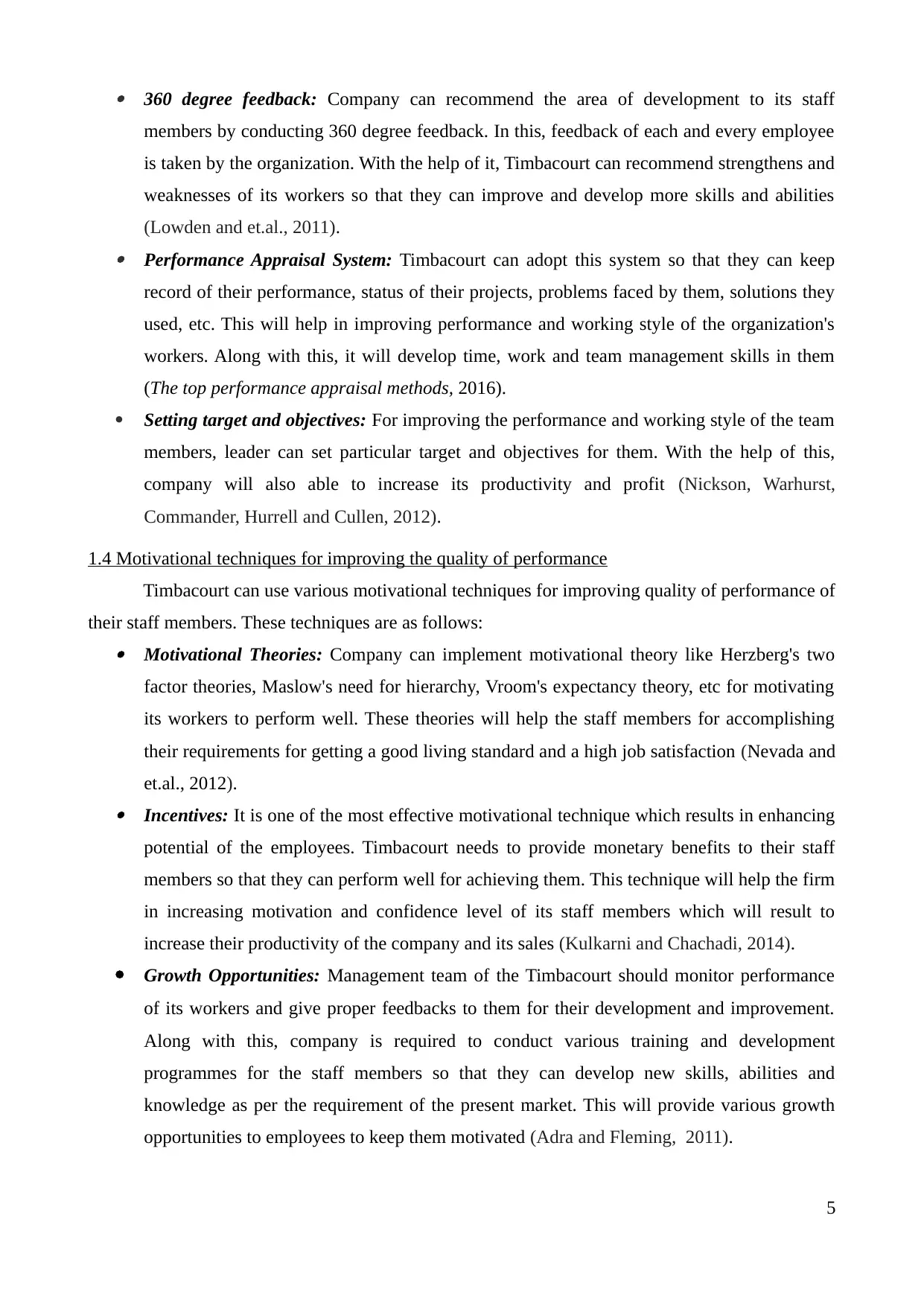
360 degree feedback: Company can recommend the area of development to its staff
members by conducting 360 degree feedback. In this, feedback of each and every employee
is taken by the organization. With the help of it, Timbacourt can recommend strengthens and
weaknesses of its workers so that they can improve and develop more skills and abilities
(Lowden and et.al., 2011). Performance Appraisal System: Timbacourt can adopt this system so that they can keep
record of their performance, status of their projects, problems faced by them, solutions they
used, etc. This will help in improving performance and working style of the organization's
workers. Along with this, it will develop time, work and team management skills in them
(The top performance appraisal methods, 2016).
Setting target and objectives: For improving the performance and working style of the team
members, leader can set particular target and objectives for them. With the help of this,
company will also able to increase its productivity and profit (Nickson, Warhurst,
Commander, Hurrell and Cullen, 2012).
1.4 Motivational techniques for improving the quality of performance
Timbacourt can use various motivational techniques for improving quality of performance of
their staff members. These techniques are as follows: Motivational Theories: Company can implement motivational theory like Herzberg's two
factor theories, Maslow's need for hierarchy, Vroom's expectancy theory, etc for motivating
its workers to perform well. These theories will help the staff members for accomplishing
their requirements for getting a good living standard and a high job satisfaction (Nevada and
et.al., 2012). Incentives: It is one of the most effective motivational technique which results in enhancing
potential of the employees. Timbacourt needs to provide monetary benefits to their staff
members so that they can perform well for achieving them. This technique will help the firm
in increasing motivation and confidence level of its staff members which will result to
increase their productivity of the company and its sales (Kulkarni and Chachadi, 2014).
Growth Opportunities: Management team of the Timbacourt should monitor performance
of its workers and give proper feedbacks to them for their development and improvement.
Along with this, company is required to conduct various training and development
programmes for the staff members so that they can develop new skills, abilities and
knowledge as per the requirement of the present market. This will provide various growth
opportunities to employees to keep them motivated (Adra and Fleming, 2011).
5
members by conducting 360 degree feedback. In this, feedback of each and every employee
is taken by the organization. With the help of it, Timbacourt can recommend strengthens and
weaknesses of its workers so that they can improve and develop more skills and abilities
(Lowden and et.al., 2011). Performance Appraisal System: Timbacourt can adopt this system so that they can keep
record of their performance, status of their projects, problems faced by them, solutions they
used, etc. This will help in improving performance and working style of the organization's
workers. Along with this, it will develop time, work and team management skills in them
(The top performance appraisal methods, 2016).
Setting target and objectives: For improving the performance and working style of the team
members, leader can set particular target and objectives for them. With the help of this,
company will also able to increase its productivity and profit (Nickson, Warhurst,
Commander, Hurrell and Cullen, 2012).
1.4 Motivational techniques for improving the quality of performance
Timbacourt can use various motivational techniques for improving quality of performance of
their staff members. These techniques are as follows: Motivational Theories: Company can implement motivational theory like Herzberg's two
factor theories, Maslow's need for hierarchy, Vroom's expectancy theory, etc for motivating
its workers to perform well. These theories will help the staff members for accomplishing
their requirements for getting a good living standard and a high job satisfaction (Nevada and
et.al., 2012). Incentives: It is one of the most effective motivational technique which results in enhancing
potential of the employees. Timbacourt needs to provide monetary benefits to their staff
members so that they can perform well for achieving them. This technique will help the firm
in increasing motivation and confidence level of its staff members which will result to
increase their productivity of the company and its sales (Kulkarni and Chachadi, 2014).
Growth Opportunities: Management team of the Timbacourt should monitor performance
of its workers and give proper feedbacks to them for their development and improvement.
Along with this, company is required to conduct various training and development
programmes for the staff members so that they can develop new skills, abilities and
knowledge as per the requirement of the present market. This will provide various growth
opportunities to employees to keep them motivated (Adra and Fleming, 2011).
5
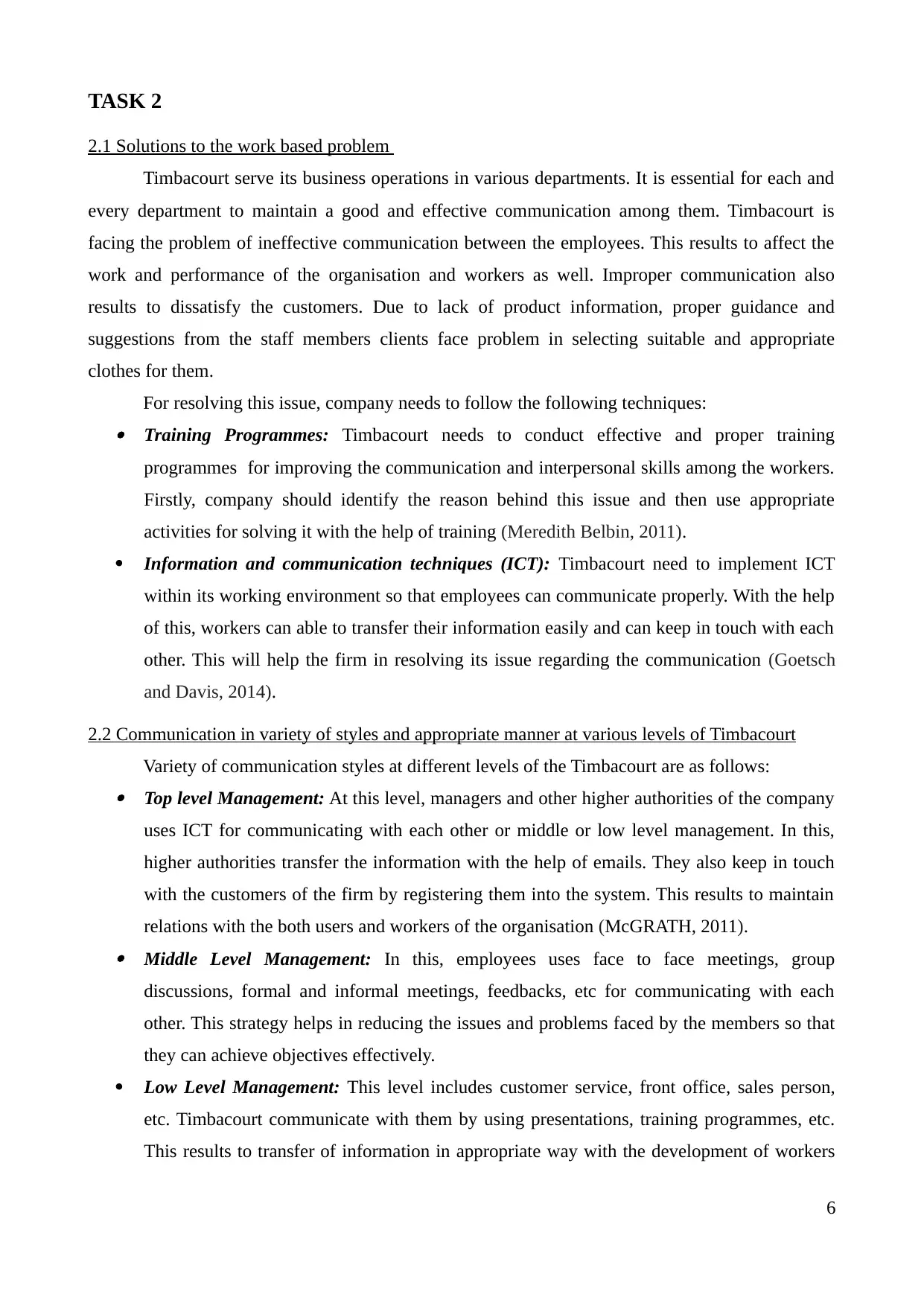
TASK 2
2.1 Solutions to the work based problem
Timbacourt serve its business operations in various departments. It is essential for each and
every department to maintain a good and effective communication among them. Timbacourt is
facing the problem of ineffective communication between the employees. This results to affect the
work and performance of the organisation and workers as well. Improper communication also
results to dissatisfy the customers. Due to lack of product information, proper guidance and
suggestions from the staff members clients face problem in selecting suitable and appropriate
clothes for them.
For resolving this issue, company needs to follow the following techniques: Training Programmes: Timbacourt needs to conduct effective and proper training
programmes for improving the communication and interpersonal skills among the workers.
Firstly, company should identify the reason behind this issue and then use appropriate
activities for solving it with the help of training (Meredith Belbin, 2011).
Information and communication techniques (ICT): Timbacourt need to implement ICT
within its working environment so that employees can communicate properly. With the help
of this, workers can able to transfer their information easily and can keep in touch with each
other. This will help the firm in resolving its issue regarding the communication (Goetsch
and Davis, 2014).
2.2 Communication in variety of styles and appropriate manner at various levels of Timbacourt
Variety of communication styles at different levels of the Timbacourt are as follows: Top level Management: At this level, managers and other higher authorities of the company
uses ICT for communicating with each other or middle or low level management. In this,
higher authorities transfer the information with the help of emails. They also keep in touch
with the customers of the firm by registering them into the system. This results to maintain
relations with the both users and workers of the organisation (McGRATH, 2011). Middle Level Management: In this, employees uses face to face meetings, group
discussions, formal and informal meetings, feedbacks, etc for communicating with each
other. This strategy helps in reducing the issues and problems faced by the members so that
they can achieve objectives effectively.
Low Level Management: This level includes customer service, front office, sales person,
etc. Timbacourt communicate with them by using presentations, training programmes, etc.
This results to transfer of information in appropriate way with the development of workers
6
2.1 Solutions to the work based problem
Timbacourt serve its business operations in various departments. It is essential for each and
every department to maintain a good and effective communication among them. Timbacourt is
facing the problem of ineffective communication between the employees. This results to affect the
work and performance of the organisation and workers as well. Improper communication also
results to dissatisfy the customers. Due to lack of product information, proper guidance and
suggestions from the staff members clients face problem in selecting suitable and appropriate
clothes for them.
For resolving this issue, company needs to follow the following techniques: Training Programmes: Timbacourt needs to conduct effective and proper training
programmes for improving the communication and interpersonal skills among the workers.
Firstly, company should identify the reason behind this issue and then use appropriate
activities for solving it with the help of training (Meredith Belbin, 2011).
Information and communication techniques (ICT): Timbacourt need to implement ICT
within its working environment so that employees can communicate properly. With the help
of this, workers can able to transfer their information easily and can keep in touch with each
other. This will help the firm in resolving its issue regarding the communication (Goetsch
and Davis, 2014).
2.2 Communication in variety of styles and appropriate manner at various levels of Timbacourt
Variety of communication styles at different levels of the Timbacourt are as follows: Top level Management: At this level, managers and other higher authorities of the company
uses ICT for communicating with each other or middle or low level management. In this,
higher authorities transfer the information with the help of emails. They also keep in touch
with the customers of the firm by registering them into the system. This results to maintain
relations with the both users and workers of the organisation (McGRATH, 2011). Middle Level Management: In this, employees uses face to face meetings, group
discussions, formal and informal meetings, feedbacks, etc for communicating with each
other. This strategy helps in reducing the issues and problems faced by the members so that
they can achieve objectives effectively.
Low Level Management: This level includes customer service, front office, sales person,
etc. Timbacourt communicate with them by using presentations, training programmes, etc.
This results to transfer of information in appropriate way with the development of workers
6
⊘ This is a preview!⊘
Do you want full access?
Subscribe today to unlock all pages.

Trusted by 1+ million students worldwide
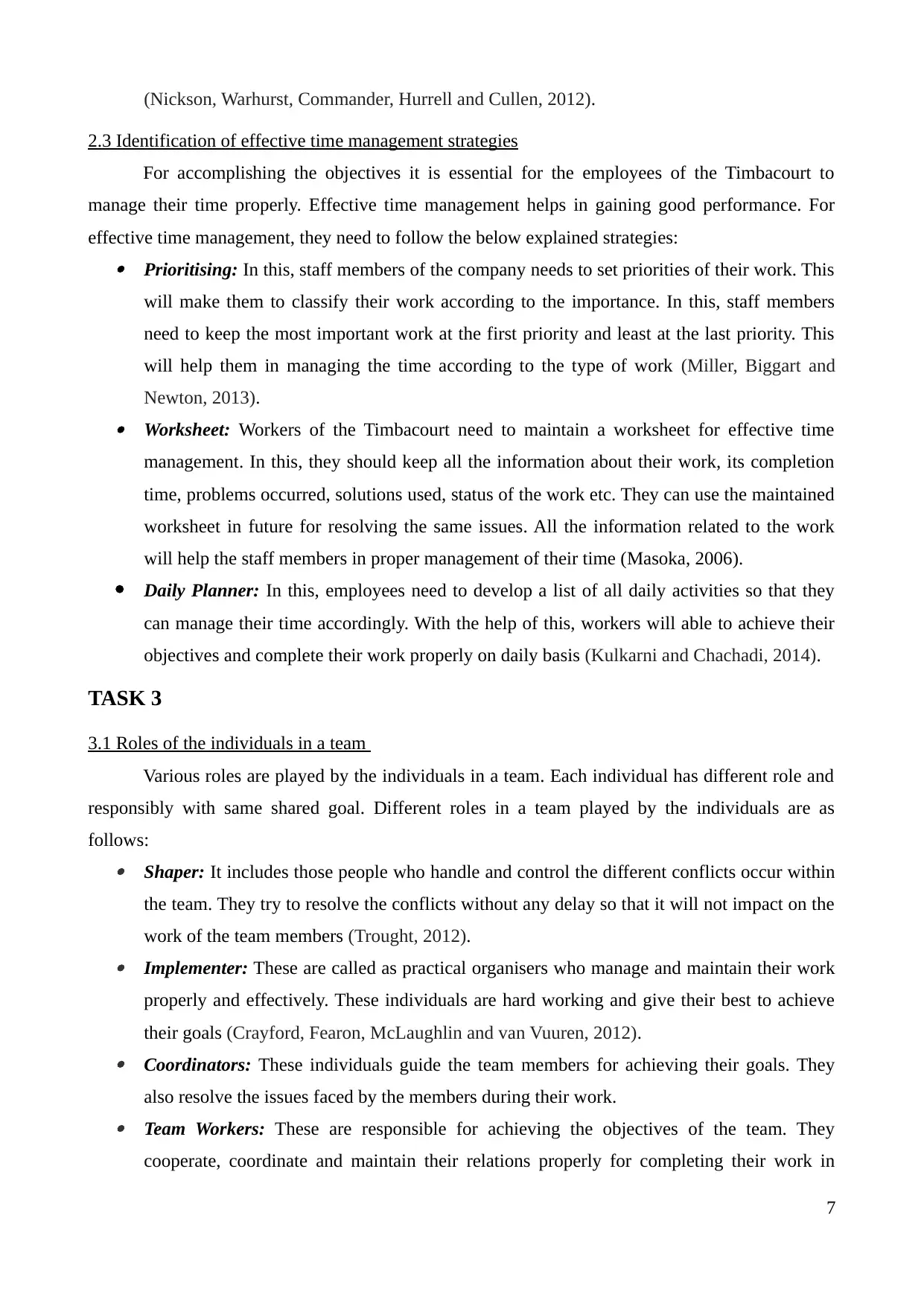
(Nickson, Warhurst, Commander, Hurrell and Cullen, 2012).
2.3 Identification of effective time management strategies
For accomplishing the objectives it is essential for the employees of the Timbacourt to
manage their time properly. Effective time management helps in gaining good performance. For
effective time management, they need to follow the below explained strategies: Prioritising: In this, staff members of the company needs to set priorities of their work. This
will make them to classify their work according to the importance. In this, staff members
need to keep the most important work at the first priority and least at the last priority. This
will help them in managing the time according to the type of work (Miller, Biggart and
Newton, 2013). Worksheet: Workers of the Timbacourt need to maintain a worksheet for effective time
management. In this, they should keep all the information about their work, its completion
time, problems occurred, solutions used, status of the work etc. They can use the maintained
worksheet in future for resolving the same issues. All the information related to the work
will help the staff members in proper management of their time (Masoka, 2006).
Daily Planner: In this, employees need to develop a list of all daily activities so that they
can manage their time accordingly. With the help of this, workers will able to achieve their
objectives and complete their work properly on daily basis (Kulkarni and Chachadi, 2014).
TASK 3
3.1 Roles of the individuals in a team
Various roles are played by the individuals in a team. Each individual has different role and
responsibly with same shared goal. Different roles in a team played by the individuals are as
follows: Shaper: It includes those people who handle and control the different conflicts occur within
the team. They try to resolve the conflicts without any delay so that it will not impact on the
work of the team members (Trought, 2012). Implementer: These are called as practical organisers who manage and maintain their work
properly and effectively. These individuals are hard working and give their best to achieve
their goals (Crayford, Fearon, McLaughlin and van Vuuren, 2012). Coordinators: These individuals guide the team members for achieving their goals. They
also resolve the issues faced by the members during their work. Team Workers: These are responsible for achieving the objectives of the team. They
cooperate, coordinate and maintain their relations properly for completing their work in
7
2.3 Identification of effective time management strategies
For accomplishing the objectives it is essential for the employees of the Timbacourt to
manage their time properly. Effective time management helps in gaining good performance. For
effective time management, they need to follow the below explained strategies: Prioritising: In this, staff members of the company needs to set priorities of their work. This
will make them to classify their work according to the importance. In this, staff members
need to keep the most important work at the first priority and least at the last priority. This
will help them in managing the time according to the type of work (Miller, Biggart and
Newton, 2013). Worksheet: Workers of the Timbacourt need to maintain a worksheet for effective time
management. In this, they should keep all the information about their work, its completion
time, problems occurred, solutions used, status of the work etc. They can use the maintained
worksheet in future for resolving the same issues. All the information related to the work
will help the staff members in proper management of their time (Masoka, 2006).
Daily Planner: In this, employees need to develop a list of all daily activities so that they
can manage their time accordingly. With the help of this, workers will able to achieve their
objectives and complete their work properly on daily basis (Kulkarni and Chachadi, 2014).
TASK 3
3.1 Roles of the individuals in a team
Various roles are played by the individuals in a team. Each individual has different role and
responsibly with same shared goal. Different roles in a team played by the individuals are as
follows: Shaper: It includes those people who handle and control the different conflicts occur within
the team. They try to resolve the conflicts without any delay so that it will not impact on the
work of the team members (Trought, 2012). Implementer: These are called as practical organisers who manage and maintain their work
properly and effectively. These individuals are hard working and give their best to achieve
their goals (Crayford, Fearon, McLaughlin and van Vuuren, 2012). Coordinators: These individuals guide the team members for achieving their goals. They
also resolve the issues faced by the members during their work. Team Workers: These are responsible for achieving the objectives of the team. They
cooperate, coordinate and maintain their relations properly for completing their work in
7
Paraphrase This Document
Need a fresh take? Get an instant paraphrase of this document with our AI Paraphraser
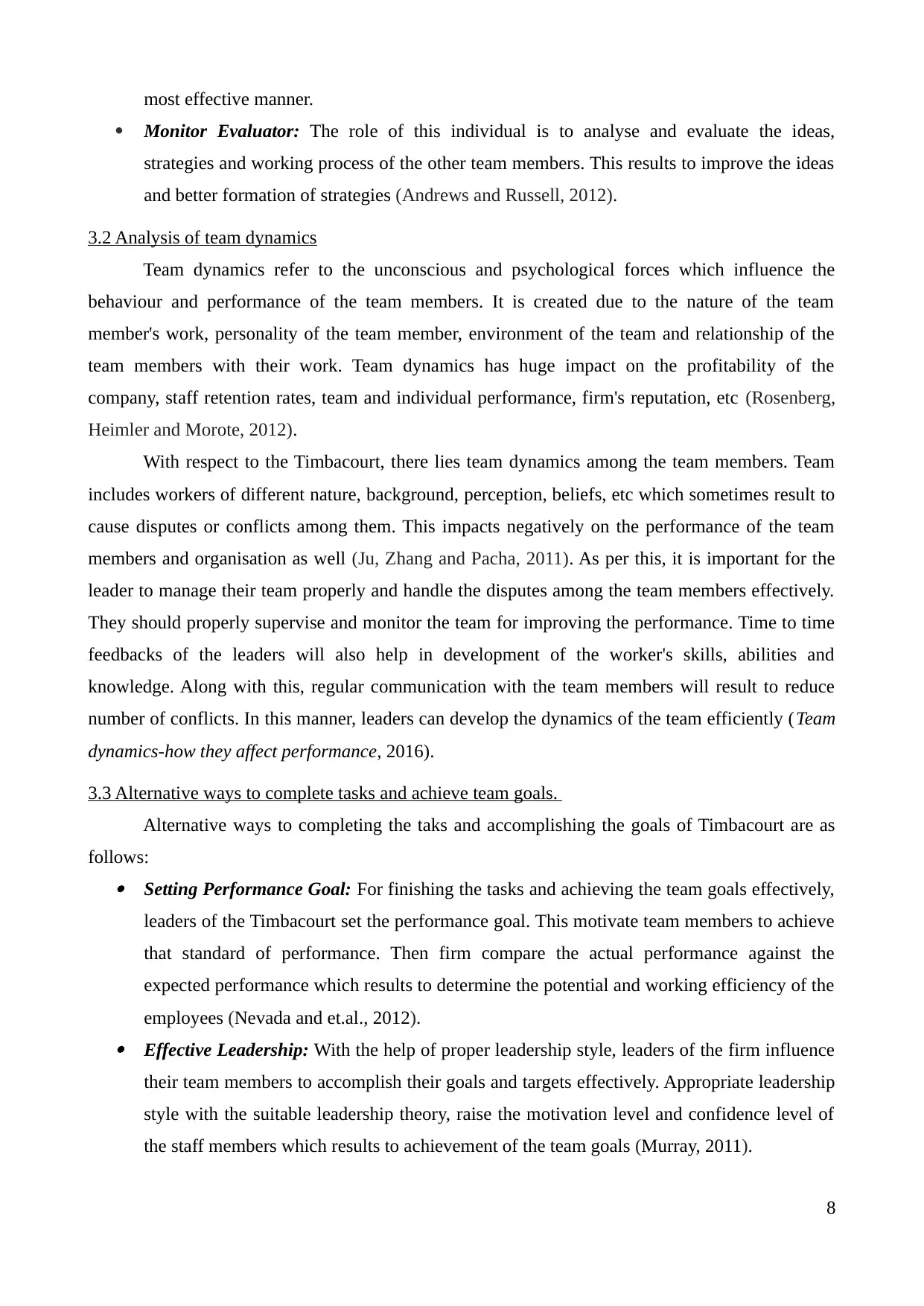
most effective manner.
Monitor Evaluator: The role of this individual is to analyse and evaluate the ideas,
strategies and working process of the other team members. This results to improve the ideas
and better formation of strategies (Andrews and Russell, 2012).
3.2 Analysis of team dynamics
Team dynamics refer to the unconscious and psychological forces which influence the
behaviour and performance of the team members. It is created due to the nature of the team
member's work, personality of the team member, environment of the team and relationship of the
team members with their work. Team dynamics has huge impact on the profitability of the
company, staff retention rates, team and individual performance, firm's reputation, etc (Rosenberg,
Heimler and Morote, 2012).
With respect to the Timbacourt, there lies team dynamics among the team members. Team
includes workers of different nature, background, perception, beliefs, etc which sometimes result to
cause disputes or conflicts among them. This impacts negatively on the performance of the team
members and organisation as well (Ju, Zhang and Pacha, 2011). As per this, it is important for the
leader to manage their team properly and handle the disputes among the team members effectively.
They should properly supervise and monitor the team for improving the performance. Time to time
feedbacks of the leaders will also help in development of the worker's skills, abilities and
knowledge. Along with this, regular communication with the team members will result to reduce
number of conflicts. In this manner, leaders can develop the dynamics of the team efficiently (Team
dynamics-how they affect performance, 2016).
3.3 Alternative ways to complete tasks and achieve team goals.
Alternative ways to completing the taks and accomplishing the goals of Timbacourt are as
follows: Setting Performance Goal: For finishing the tasks and achieving the team goals effectively,
leaders of the Timbacourt set the performance goal. This motivate team members to achieve
that standard of performance. Then firm compare the actual performance against the
expected performance which results to determine the potential and working efficiency of the
employees (Nevada and et.al., 2012). Effective Leadership: With the help of proper leadership style, leaders of the firm influence
their team members to accomplish their goals and targets effectively. Appropriate leadership
style with the suitable leadership theory, raise the motivation level and confidence level of
the staff members which results to achievement of the team goals (Murray, 2011).
8
Monitor Evaluator: The role of this individual is to analyse and evaluate the ideas,
strategies and working process of the other team members. This results to improve the ideas
and better formation of strategies (Andrews and Russell, 2012).
3.2 Analysis of team dynamics
Team dynamics refer to the unconscious and psychological forces which influence the
behaviour and performance of the team members. It is created due to the nature of the team
member's work, personality of the team member, environment of the team and relationship of the
team members with their work. Team dynamics has huge impact on the profitability of the
company, staff retention rates, team and individual performance, firm's reputation, etc (Rosenberg,
Heimler and Morote, 2012).
With respect to the Timbacourt, there lies team dynamics among the team members. Team
includes workers of different nature, background, perception, beliefs, etc which sometimes result to
cause disputes or conflicts among them. This impacts negatively on the performance of the team
members and organisation as well (Ju, Zhang and Pacha, 2011). As per this, it is important for the
leader to manage their team properly and handle the disputes among the team members effectively.
They should properly supervise and monitor the team for improving the performance. Time to time
feedbacks of the leaders will also help in development of the worker's skills, abilities and
knowledge. Along with this, regular communication with the team members will result to reduce
number of conflicts. In this manner, leaders can develop the dynamics of the team efficiently (Team
dynamics-how they affect performance, 2016).
3.3 Alternative ways to complete tasks and achieve team goals.
Alternative ways to completing the taks and accomplishing the goals of Timbacourt are as
follows: Setting Performance Goal: For finishing the tasks and achieving the team goals effectively,
leaders of the Timbacourt set the performance goal. This motivate team members to achieve
that standard of performance. Then firm compare the actual performance against the
expected performance which results to determine the potential and working efficiency of the
employees (Nevada and et.al., 2012). Effective Leadership: With the help of proper leadership style, leaders of the firm influence
their team members to accomplish their goals and targets effectively. Appropriate leadership
style with the suitable leadership theory, raise the motivation level and confidence level of
the staff members which results to achievement of the team goals (Murray, 2011).
8
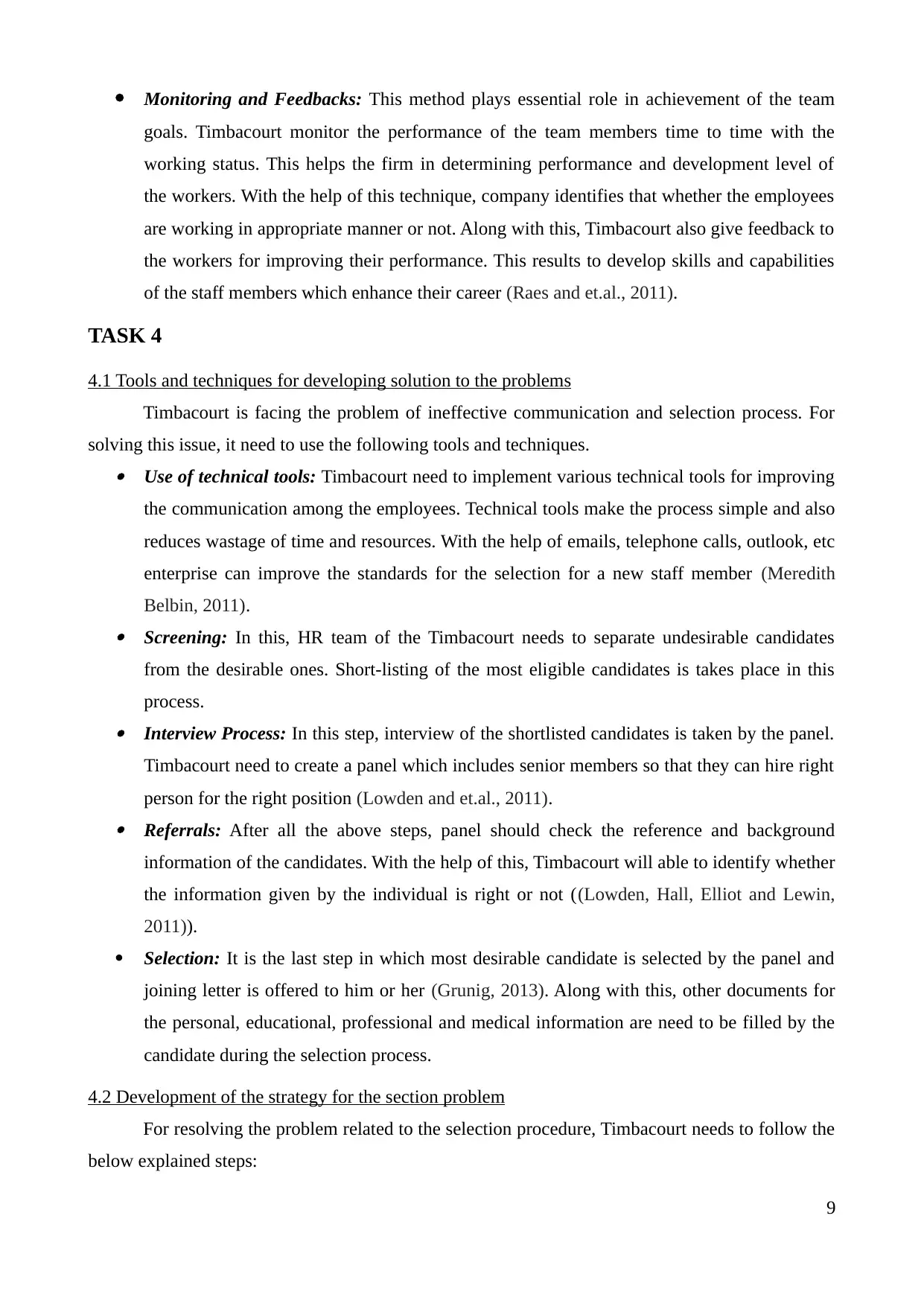
Monitoring and Feedbacks: This method plays essential role in achievement of the team
goals. Timbacourt monitor the performance of the team members time to time with the
working status. This helps the firm in determining performance and development level of
the workers. With the help of this technique, company identifies that whether the employees
are working in appropriate manner or not. Along with this, Timbacourt also give feedback to
the workers for improving their performance. This results to develop skills and capabilities
of the staff members which enhance their career (Raes and et.al., 2011).
TASK 4
4.1 Tools and techniques for developing solution to the problems
Timbacourt is facing the problem of ineffective communication and selection process. For
solving this issue, it need to use the following tools and techniques. Use of technical tools: Timbacourt need to implement various technical tools for improving
the communication among the employees. Technical tools make the process simple and also
reduces wastage of time and resources. With the help of emails, telephone calls, outlook, etc
enterprise can improve the standards for the selection for a new staff member (Meredith
Belbin, 2011). Screening: In this, HR team of the Timbacourt needs to separate undesirable candidates
from the desirable ones. Short-listing of the most eligible candidates is takes place in this
process. Interview Process: In this step, interview of the shortlisted candidates is taken by the panel.
Timbacourt need to create a panel which includes senior members so that they can hire right
person for the right position (Lowden and et.al., 2011). Referrals: After all the above steps, panel should check the reference and background
information of the candidates. With the help of this, Timbacourt will able to identify whether
the information given by the individual is right or not ((Lowden, Hall, Elliot and Lewin,
2011)).
Selection: It is the last step in which most desirable candidate is selected by the panel and
joining letter is offered to him or her (Grunig, 2013). Along with this, other documents for
the personal, educational, professional and medical information are need to be filled by the
candidate during the selection process.
4.2 Development of the strategy for the section problem
For resolving the problem related to the selection procedure, Timbacourt needs to follow the
below explained steps:
9
goals. Timbacourt monitor the performance of the team members time to time with the
working status. This helps the firm in determining performance and development level of
the workers. With the help of this technique, company identifies that whether the employees
are working in appropriate manner or not. Along with this, Timbacourt also give feedback to
the workers for improving their performance. This results to develop skills and capabilities
of the staff members which enhance their career (Raes and et.al., 2011).
TASK 4
4.1 Tools and techniques for developing solution to the problems
Timbacourt is facing the problem of ineffective communication and selection process. For
solving this issue, it need to use the following tools and techniques. Use of technical tools: Timbacourt need to implement various technical tools for improving
the communication among the employees. Technical tools make the process simple and also
reduces wastage of time and resources. With the help of emails, telephone calls, outlook, etc
enterprise can improve the standards for the selection for a new staff member (Meredith
Belbin, 2011). Screening: In this, HR team of the Timbacourt needs to separate undesirable candidates
from the desirable ones. Short-listing of the most eligible candidates is takes place in this
process. Interview Process: In this step, interview of the shortlisted candidates is taken by the panel.
Timbacourt need to create a panel which includes senior members so that they can hire right
person for the right position (Lowden and et.al., 2011). Referrals: After all the above steps, panel should check the reference and background
information of the candidates. With the help of this, Timbacourt will able to identify whether
the information given by the individual is right or not ((Lowden, Hall, Elliot and Lewin,
2011)).
Selection: It is the last step in which most desirable candidate is selected by the panel and
joining letter is offered to him or her (Grunig, 2013). Along with this, other documents for
the personal, educational, professional and medical information are need to be filled by the
candidate during the selection process.
4.2 Development of the strategy for the section problem
For resolving the problem related to the selection procedure, Timbacourt needs to follow the
below explained steps:
9
⊘ This is a preview!⊘
Do you want full access?
Subscribe today to unlock all pages.

Trusted by 1+ million students worldwide
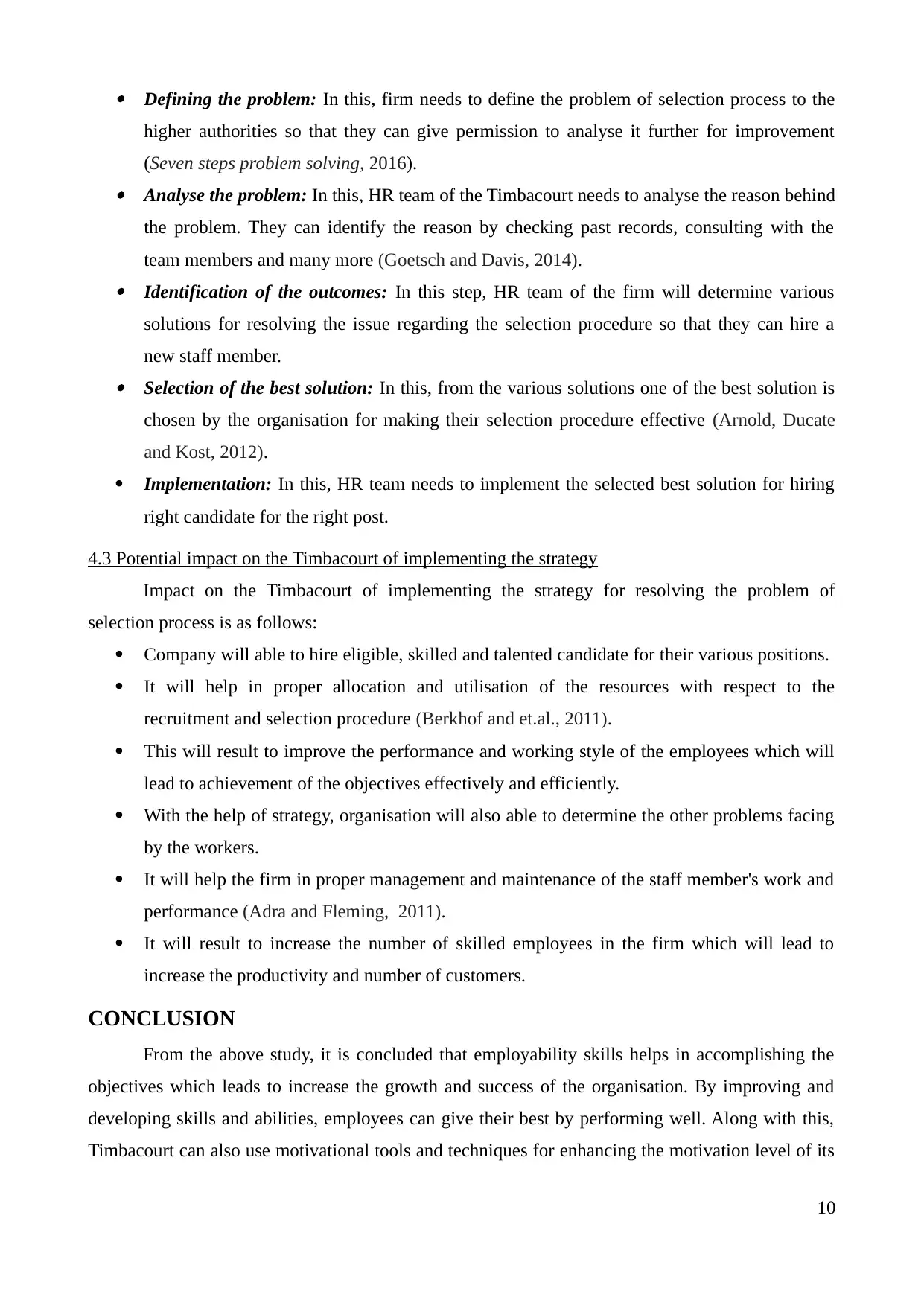
Defining the problem: In this, firm needs to define the problem of selection process to the
higher authorities so that they can give permission to analyse it further for improvement
(Seven steps problem solving, 2016). Analyse the problem: In this, HR team of the Timbacourt needs to analyse the reason behind
the problem. They can identify the reason by checking past records, consulting with the
team members and many more (Goetsch and Davis, 2014). Identification of the outcomes: In this step, HR team of the firm will determine various
solutions for resolving the issue regarding the selection procedure so that they can hire a
new staff member. Selection of the best solution: In this, from the various solutions one of the best solution is
chosen by the organisation for making their selection procedure effective (Arnold, Ducate
and Kost, 2012).
Implementation: In this, HR team needs to implement the selected best solution for hiring
right candidate for the right post.
4.3 Potential impact on the Timbacourt of implementing the strategy
Impact on the Timbacourt of implementing the strategy for resolving the problem of
selection process is as follows:
Company will able to hire eligible, skilled and talented candidate for their various positions.
It will help in proper allocation and utilisation of the resources with respect to the
recruitment and selection procedure (Berkhof and et.al., 2011).
This will result to improve the performance and working style of the employees which will
lead to achievement of the objectives effectively and efficiently.
With the help of strategy, organisation will also able to determine the other problems facing
by the workers.
It will help the firm in proper management and maintenance of the staff member's work and
performance (Adra and Fleming, 2011).
It will result to increase the number of skilled employees in the firm which will lead to
increase the productivity and number of customers.
CONCLUSION
From the above study, it is concluded that employability skills helps in accomplishing the
objectives which leads to increase the growth and success of the organisation. By improving and
developing skills and abilities, employees can give their best by performing well. Along with this,
Timbacourt can also use motivational tools and techniques for enhancing the motivation level of its
10
higher authorities so that they can give permission to analyse it further for improvement
(Seven steps problem solving, 2016). Analyse the problem: In this, HR team of the Timbacourt needs to analyse the reason behind
the problem. They can identify the reason by checking past records, consulting with the
team members and many more (Goetsch and Davis, 2014). Identification of the outcomes: In this step, HR team of the firm will determine various
solutions for resolving the issue regarding the selection procedure so that they can hire a
new staff member. Selection of the best solution: In this, from the various solutions one of the best solution is
chosen by the organisation for making their selection procedure effective (Arnold, Ducate
and Kost, 2012).
Implementation: In this, HR team needs to implement the selected best solution for hiring
right candidate for the right post.
4.3 Potential impact on the Timbacourt of implementing the strategy
Impact on the Timbacourt of implementing the strategy for resolving the problem of
selection process is as follows:
Company will able to hire eligible, skilled and talented candidate for their various positions.
It will help in proper allocation and utilisation of the resources with respect to the
recruitment and selection procedure (Berkhof and et.al., 2011).
This will result to improve the performance and working style of the employees which will
lead to achievement of the objectives effectively and efficiently.
With the help of strategy, organisation will also able to determine the other problems facing
by the workers.
It will help the firm in proper management and maintenance of the staff member's work and
performance (Adra and Fleming, 2011).
It will result to increase the number of skilled employees in the firm which will lead to
increase the productivity and number of customers.
CONCLUSION
From the above study, it is concluded that employability skills helps in accomplishing the
objectives which leads to increase the growth and success of the organisation. By improving and
developing skills and abilities, employees can give their best by performing well. Along with this,
Timbacourt can also use motivational tools and techniques for enhancing the motivation level of its
10
Paraphrase This Document
Need a fresh take? Get an instant paraphrase of this document with our AI Paraphraser
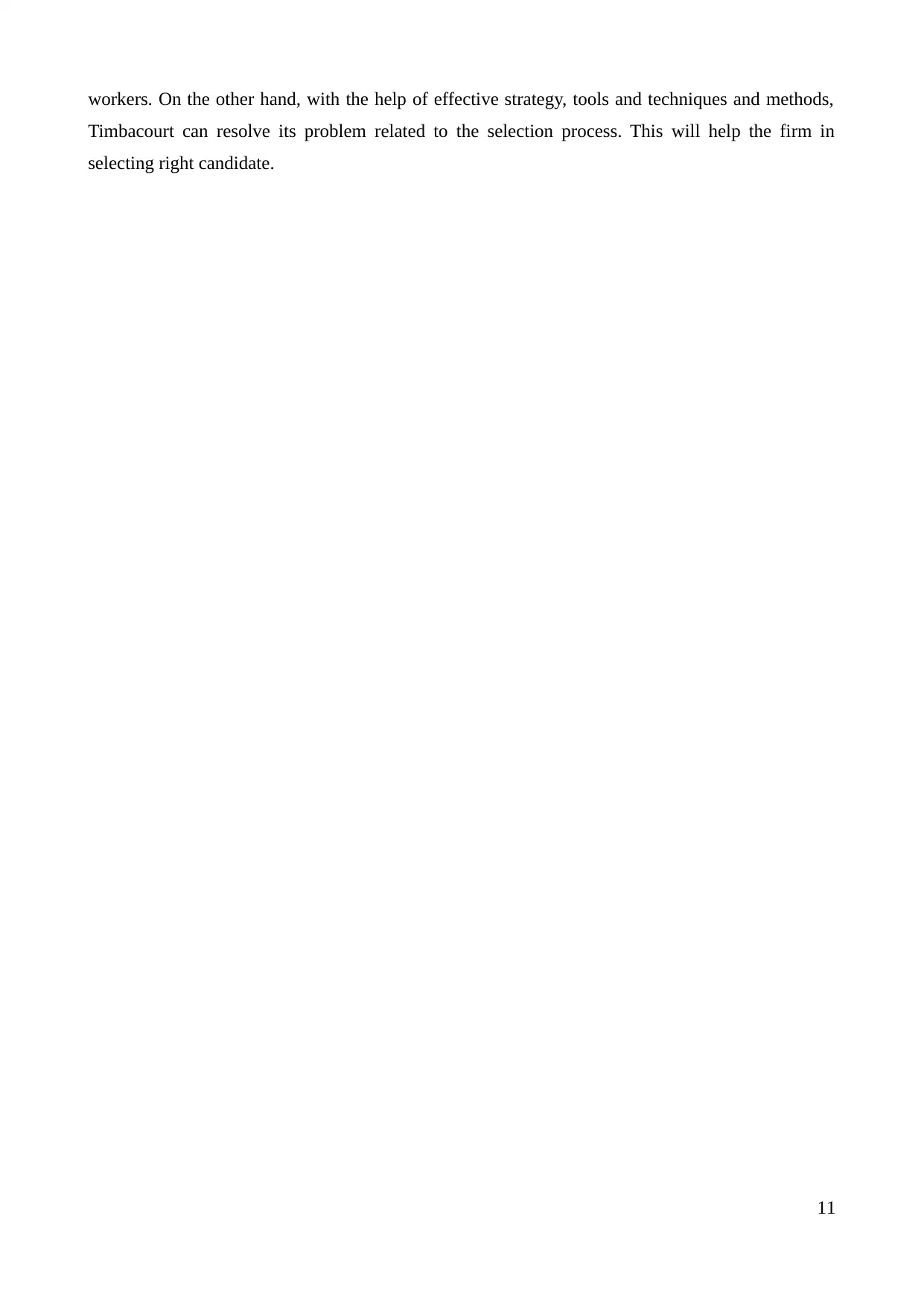
workers. On the other hand, with the help of effective strategy, tools and techniques and methods,
Timbacourt can resolve its problem related to the selection process. This will help the firm in
selecting right candidate.
11
Timbacourt can resolve its problem related to the selection process. This will help the firm in
selecting right candidate.
11
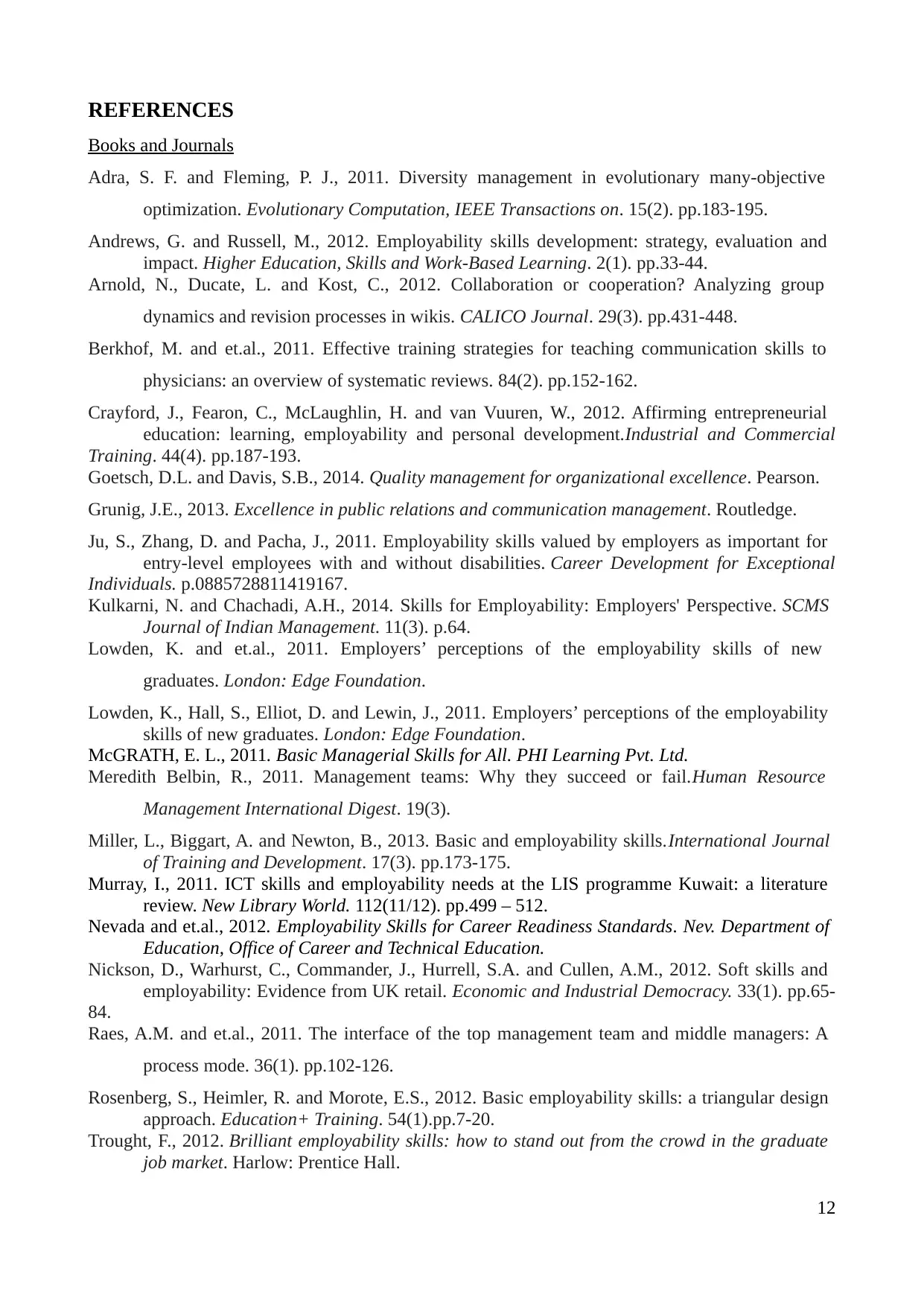
REFERENCES
Books and Journals
Adra, S. F. and Fleming, P. J., 2011. Diversity management in evolutionary many-objective
optimization. Evolutionary Computation, IEEE Transactions on. 15(2). pp.183-195.
Andrews, G. and Russell, M., 2012. Employability skills development: strategy, evaluation and
impact. Higher Education, Skills and Work-Based Learning. 2(1). pp.33-44.
Arnold, N., Ducate, L. and Kost, C., 2012. Collaboration or cooperation? Analyzing group
dynamics and revision processes in wikis. CALICO Journal. 29(3). pp.431-448.
Berkhof, M. and et.al., 2011. Effective training strategies for teaching communication skills to
physicians: an overview of systematic reviews. 84(2). pp.152-162.
Crayford, J., Fearon, C., McLaughlin, H. and van Vuuren, W., 2012. Affirming entrepreneurial
education: learning, employability and personal development.Industrial and Commercial
Training. 44(4). pp.187-193.
Goetsch, D.L. and Davis, S.B., 2014. Quality management for organizational excellence. Pearson.
Grunig, J.E., 2013. Excellence in public relations and communication management. Routledge.
Ju, S., Zhang, D. and Pacha, J., 2011. Employability skills valued by employers as important for
entry-level employees with and without disabilities. Career Development for Exceptional
Individuals. p.0885728811419167.
Kulkarni, N. and Chachadi, A.H., 2014. Skills for Employability: Employers' Perspective. SCMS
Journal of Indian Management. 11(3). p.64.
Lowden, K. and et.al., 2011. Employers’ perceptions of the employability skills of new
graduates. London: Edge Foundation.
Lowden, K., Hall, S., Elliot, D. and Lewin, J., 2011. Employers’ perceptions of the employability
skills of new graduates. London: Edge Foundation.
McGRATH, E. L., 2011. Basic Managerial Skills for All. PHI Learning Pvt. Ltd.
Meredith Belbin, R., 2011. Management teams: Why they succeed or fail.Human Resource
Management International Digest. 19(3).
Miller, L., Biggart, A. and Newton, B., 2013. Basic and employability skills.International Journal
of Training and Development. 17(3). pp.173-175.
Murray, I., 2011. ICT skills and employability needs at the LIS programme Kuwait: a literature
review. New Library World. 112(11/12). pp.499 – 512.
Nevada and et.al., 2012. Employability Skills for Career Readiness Standards. Nev. Department of
Education, Office of Career and Technical Education.
Nickson, D., Warhurst, C., Commander, J., Hurrell, S.A. and Cullen, A.M., 2012. Soft skills and
employability: Evidence from UK retail. Economic and Industrial Democracy. 33(1). pp.65-
84.
Raes, A.M. and et.al., 2011. The interface of the top management team and middle managers: A
process mode. 36(1). pp.102-126.
Rosenberg, S., Heimler, R. and Morote, E.S., 2012. Basic employability skills: a triangular design
approach. Education+ Training. 54(1).pp.7-20.
Trought, F., 2012. Brilliant employability skills: how to stand out from the crowd in the graduate
job market. Harlow: Prentice Hall.
12
Books and Journals
Adra, S. F. and Fleming, P. J., 2011. Diversity management in evolutionary many-objective
optimization. Evolutionary Computation, IEEE Transactions on. 15(2). pp.183-195.
Andrews, G. and Russell, M., 2012. Employability skills development: strategy, evaluation and
impact. Higher Education, Skills and Work-Based Learning. 2(1). pp.33-44.
Arnold, N., Ducate, L. and Kost, C., 2012. Collaboration or cooperation? Analyzing group
dynamics and revision processes in wikis. CALICO Journal. 29(3). pp.431-448.
Berkhof, M. and et.al., 2011. Effective training strategies for teaching communication skills to
physicians: an overview of systematic reviews. 84(2). pp.152-162.
Crayford, J., Fearon, C., McLaughlin, H. and van Vuuren, W., 2012. Affirming entrepreneurial
education: learning, employability and personal development.Industrial and Commercial
Training. 44(4). pp.187-193.
Goetsch, D.L. and Davis, S.B., 2014. Quality management for organizational excellence. Pearson.
Grunig, J.E., 2013. Excellence in public relations and communication management. Routledge.
Ju, S., Zhang, D. and Pacha, J., 2011. Employability skills valued by employers as important for
entry-level employees with and without disabilities. Career Development for Exceptional
Individuals. p.0885728811419167.
Kulkarni, N. and Chachadi, A.H., 2014. Skills for Employability: Employers' Perspective. SCMS
Journal of Indian Management. 11(3). p.64.
Lowden, K. and et.al., 2011. Employers’ perceptions of the employability skills of new
graduates. London: Edge Foundation.
Lowden, K., Hall, S., Elliot, D. and Lewin, J., 2011. Employers’ perceptions of the employability
skills of new graduates. London: Edge Foundation.
McGRATH, E. L., 2011. Basic Managerial Skills for All. PHI Learning Pvt. Ltd.
Meredith Belbin, R., 2011. Management teams: Why they succeed or fail.Human Resource
Management International Digest. 19(3).
Miller, L., Biggart, A. and Newton, B., 2013. Basic and employability skills.International Journal
of Training and Development. 17(3). pp.173-175.
Murray, I., 2011. ICT skills and employability needs at the LIS programme Kuwait: a literature
review. New Library World. 112(11/12). pp.499 – 512.
Nevada and et.al., 2012. Employability Skills for Career Readiness Standards. Nev. Department of
Education, Office of Career and Technical Education.
Nickson, D., Warhurst, C., Commander, J., Hurrell, S.A. and Cullen, A.M., 2012. Soft skills and
employability: Evidence from UK retail. Economic and Industrial Democracy. 33(1). pp.65-
84.
Raes, A.M. and et.al., 2011. The interface of the top management team and middle managers: A
process mode. 36(1). pp.102-126.
Rosenberg, S., Heimler, R. and Morote, E.S., 2012. Basic employability skills: a triangular design
approach. Education+ Training. 54(1).pp.7-20.
Trought, F., 2012. Brilliant employability skills: how to stand out from the crowd in the graduate
job market. Harlow: Prentice Hall.
12
⊘ This is a preview!⊘
Do you want full access?
Subscribe today to unlock all pages.

Trusted by 1+ million students worldwide
1 out of 14
Related Documents
Your All-in-One AI-Powered Toolkit for Academic Success.
+13062052269
info@desklib.com
Available 24*7 on WhatsApp / Email
![[object Object]](/_next/static/media/star-bottom.7253800d.svg)
Unlock your academic potential
Copyright © 2020–2025 A2Z Services. All Rights Reserved. Developed and managed by ZUCOL.





